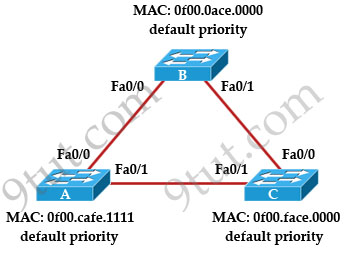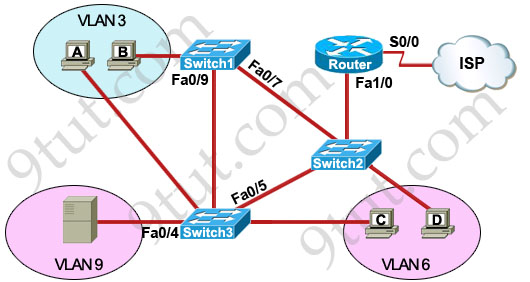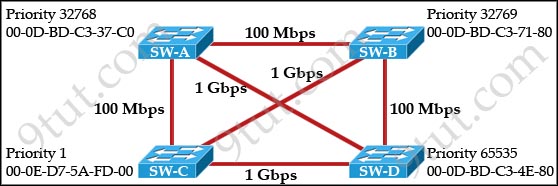New CCNA – STP
Note: If you are not sure about Spanning Tree Protocol, please read our Spanning Tree Protocol STP Tutorial (Premium Tutorial).
Question 1
Refer to the topology shown in the exhibit. Which ports will be STP designated ports if all the links are operating at the same bandwidth? (Choose three)

A. Switch A – Fa0/0
B. Switch A – Fa0/1
C. Switch B – Fa0/0
D. Switch B – Fa0/1
E. Switch C – Fa0/0
F. Switch C – Fa0/1
Answer: B C D
Explanation
First by comparing their MAC addresses we learn that switch B will be root bridge as it has lowest MAC. Therefore all of its ports are designated ports -> C & D are correct.
On the link between switch A & switch C there must have one designated port and one non-designated (blocked) port. We can figure out which port is designated port by comparing their MAC address again. A has lower MAC so Fa0/1 of switch A will be designated port while Fa0/1 of switch C will be blocked -> B is correct.
Question 2
What value is primarily used to determine which port becomes the root port on each non-root switch in a spanning-tree topology?
A. lowest port MAC address
B. port priority number and MAC address.
C. VTP revision number
D. highest port priority number.
E. path cost
Answer: E
Explanation
The path cost to the root bridge is the most important value to determine which port will become the root port on each non-root switch. In particular, the port with lowest cost to the root bridge will become root port (on non-root switch).
Question 3
What is one benefit of PVST+?
A. PVST+ reduces the CPU cycles for all the switches in the network.
B. PVST+ automatically selects the root bridge location, to provide optimization.
C. PVST+ allows the root switch location to be optimized per vlan.
D. PVST+ supports Layer 3 load balancing without loops.
Answer: C
Explanation
Per VLAN Spanning Tree (PVST) maintains a spanning tree instance for each VLAN configured in the network. It means a switch can be the root bridge of a VLAN while another switch can be the root bridge of other VLANs in a common topology. For example, Switch 1 can be the root bridge for Voice data while Switch 2 can be the root bridge for Video data. If designed correctly, it can optimize the network traffic.
Question 4
Which two protocols are used by bridges and/or switches to prevent loops in a layer 2 network? (Choose two)
A. 802.1d
B. VTP
C. 802.1q
D. STP
E. SAP
Answer: A D
Question 5
In which circumstance are multiple copies of the same unicast frame likely to be transmitted in a switched LAN?
A. after broken links are re-established
B. in an improperly implemented redundant topology
C. when upper-layer protocols require high reliability
D. during high traffic periods
E. when a dual ring topology is in use
Answer: B
Explanation
If we connect two switches via 2 or more links and do not enable STP on these switches then a loop (which creates multiple copies of the same unicast frame) will occur. It is an example of an improperly implemented redundant topology.
Question 6
Refer to the exhibit.

A problem with network connectivity has been observed. It is suspected that the cable connected to switch port Fa0/9 on Switch1 is disconnected. What would be an effect of this cable being disconnected?
A. Host B would not be able to access the server in VLAN9 until the cable is reconnected.
B. Communication between VLAN3 and the other VLANs would be disabled.
C. The transfer of files from Host B to the server in VLAN9 would be significantly slower.
D. For less than a minute, Host B would not be able to access the server in VLAN9. Then normal network function would resume.
Answer: D
Question 7
Which port state is introduced by Rapid-PVST?
A. learning
B. listening
C. discarding
D. forwarding
Answer: C
Explanation
PVST+ is based on IEEE802.1D Spanning Tree Protocol (STP). But PVST+ has only 3 port states (discarding, learning and forwarding) while STP has 5 port states (blocking, listening, learning, forwarding and disabled). So discarding is a new port state in PVST+.
Question 8
Refer to the exhibit. Based on the information given, which switch will be elected root bridge and why?

A. Switch A, because it has the lowest MAC address
B. Switch A, because it is the most centrally located switch
C. Switch B, because it has the highest MAC address
D. Switch C, because it is the most centrally located switch
E. Switch C, because it has the lowest priority
F. Switch D, because it has the highest priority
Answer: E
Question 9
Which term describes a spanning-tree network that has all switch ports in either the blocking or forwarding state?
A. redundant
B. spanned
C. provisioned
D. converged
Answer: D
Explanation
Spanning Tree Protocol convergence (Layer 2 convergence) happens when bridges and switches have transitioned to either the forwarding or blocking state. When layer 2 is converged, root bridge is elected and all port roles (Root, Designated and Non-Designated) in all switches are selected.
Question 10
Refer to the exhibit. Given the output shown from this Cisco Catalyst 2950, what is the most likely reason that interface FastEthernet 0/10 is not the root port for VLAN 2?
Switch# show spanning-tree interface fastethernet0/10

A. This switch has more than one interface connected to the root network segment in VLAN 2.
B. This switch is running RSTP while the elected designated switch is running 802.1d Spanning Tree.
C. This switch interface has a higher path cost to the root bridge than another in the topology.
D. This switch has a lower bridge ID for VLAN 2 than the elected designated switch.
Answer: C



Question 1 was in today’s exam. Thanks 9tut.
thanks 9tut for update questions :D
Pls update question 6 picture
Hello Guys I hope you will be fine there.Now New CCNA (200-120) and CCNA security (640-554) Vouchers on special discount of 58% for World wide, with six months expiry date till you purchase. Each voucher cost 70USD.
Details Required For CCNA Voucher For Discount Processing:
1-Full Name. 1st Name & Last Name (as you want to appear on certificate & documents)
2-Country.
3-City.
4-State.
5-Pin Code (or Area Code)
6-Residential Address (or where you can collect your Certificate or further correspondence
can be received)
7-Date of birth
Add me on Skype through this information which is written below:
Skype Name: rockon660
you can also email me at this email address which is written below:
madeelqaiser@gmail.com
If you have any Questions feel free to contact me.
Thanks,
Best regards,
Adeel
Question 6 image is broken…
There is nothing to border about New ccna what about CCNP has any thing change in CCNP
The CCNP is dived into how many branch thank in advance
anybody explain me question no .10.answer
Hey yogesh
Try to relate the question 10 with the question 1 and you´ll see that is very similar!!
9tut I wish you could remove some of the scams from being posted. I have seen people respond and say they just got their personal information stolen.
Hey Yogesh, sorry for late reply about your question, actually when show writte command sh spanning-tree int or sh spanning-tree int fa0/1 or whatever interface connected to the switch, this will display path cost, designated port and non designated port, so for the switch to be root brigde it must has all states designated, one it has blocked state is not a root brigde anymore, reason can be due to it’s max path cost than any other in the topology
thanx friend
LATEST FREE CCNA TRAINING VIDEOS
youtube.com/CiscoTrainingVideos
if i study questions from 9tut and dumps is that enough to pass
Just took it yesterday, I PASSED with a 920, thanks to 9tut…woooohhhooooo!!!!
Can someone explain Q6 answer? Seems A is also true? TIA “)
Hi Newbie, for normal operations Switch1,2 and 3 will converge and one port will be in blocking state(STP) if we assume that the primary root for B to communicate with sever is thorugh switch1 port fa0/9 then fa0/7 will be the redundant route to the server. when fa0/9 goes down STP will go through listening, learning to forwarding state. this make D the correct answer for Q6
I have a Questions on “Q3″.
I think “D” is also “Right”
Am I wrong?
Does anybody know why “D” is wrong?
Shawn, it is because D uses the term “layer 3″, but switching is layer 2.
can any one explain the question 8?
Hi, can anyone ps email me info on how to get the latest VCE 3.4.2 crack version or the version that can open recent dumps.
My email address is: mehdi01912330796@gmail.com
Thanks.
Q 6 icant understand …..thx u
in first questions, one of the answer is mistake.. lower mac has switch C.. because cafe and face, ther is face higher.. there will be correct answers ACD
srsly now what r u talking about, the correct answer is there get your information straight.
Hi everyone is any explanation about Q6 ? i am really confused about it .
Answer for Q6.
When a port is disconnected from the switch, new Election process will be taken off. the election process will take few minutes. at that time the network will be slow. Once the election is over, the network will start function normally..
So answer is
D. For less than a minute, Host B would not be able to access the server in VLAN9. Then normal network function would resume.
please let us know if you recently passed CCNA and what is the name of dump u used
Thanks.
I cleared 200-120
Question 5 in today’s exam
Almost all questions from 9tut
Thanks everyone :)
What dump did you study?
Cisco.Actualtests.200-120.v2014-02-12.by.GillBeast.299q <—— this one??
please can somebody explain mi question 1,3, and 10?? rest are ok but this 3 questions im lost. Thank you!
Q1.
Switch B is the Rood Bridge since all switches have a default priority and it has the lowest MAC Address. The Root Bridge will always have all its ports in a “Designated” status.
Both Siwtch A and C will have interface Fa0/0 as “Root” since they connect to the Root Bridge (Switch B).
Last, we need to select which Fa0/1 out of switch A and C will be in a designated status. Since the MAC address of Switch 1 is lower the it becomes “Designated”.
Q3. With PVST you can configure the Root Bridge to be on different switches for each VLAN if you anted to.
Q10. Since we see that VLAN2 is a in BLK status we can assume that there is another interface that connects to the root bridge, and the way that STP elects which port to be in a forwarding status is with the lowest path cost. That is why we can choose C, because this interface has a higher path cost then another interface that connects tot he Root Bridge.
I feel ready for the theory, can someone please tell me a site where i can find some laboratories to make practice..?
in q 10 the ans must be A “A. This switch has more than one interface connected to the root network segment in VLAN 2.” then only an int could be im ALTN BLK (option C)
@imp: For the question no.10 “C” is the right answer coz ….. The port will be blocked only when it has highest cost to reach the root bridge hence we conclude answer is C.
Q3,5,6,7 were in the today exam
Question 7 was in the exam recently
bonjour.
j’aimerai composer cisco .juste je pose la question est ce que ce possible de compose en français .
I could not understand Q10 and the answer.Somebody pls explain me that question and its answer
Question 10 is a bit tricky.
Note that only two VLANs are in Root FWD mode. This indicates that there are one of three things going on:
1. Two Root switches – one for each VLAN (In this case one for 1+3, and one for 2).
2. Root cost was modified on the -current- switch using: (configure-if)# spanning-tree vlan 2 cost (on a different IF also connected to the root switch)
3. Port priority was modified on the -root- switch: (configure-if)# spanning-tree vlan 2 port-priority (on a different IF connecting to this switch)
Option 2 and 3 can use a topology of two switches with redundant connections to one another.
For option 1 it has to be atleast three switches (fully meshed).
All three options point to answer C because all point to difference in cost (apart from option 3 since priority isn’t even a possible answer).
As for answer A. I’m not 100% sure what they mean by “segment”. I’m thinking two switches with one extra link between them.
This would, with default configurations, put ALL VLANs in the same STP state on each interface. For it to result in discontigous STP states between VLANs, there has to be modifications to the cost or priority – which leads to answer C anyway.
It’s all about the way STP chooses path: 1. Root cost – 2. BID – 3. Interface priority (low) – 4. Interface number (low)
Hope this helps.
Thanks for the awesome explanation!
Keep writing :)
Passed Marks: 975, 99.8% from 9tut no need to exert effort for latest dumps. Labs EIGRP, ACL Sim 1 & 2, practice all modifications coz it was given on random. 9tut is enough to pass the exam. GoodLuck. .
Destrosiers: what do u mean by modification in labs ? thanks.
check the labs given here and you will know
destrosiers is fake….
Was thinking the same thing. @Vikas
Hello
I have a doubt with the Questioon 8.
I think it can not be possible to be right, because, despite the SW-C has the lower priotity, the IOS can’t let you type vlan priorities without an increment of 4096, we can not put priority 1, the IOS wont allow it!
must be a mistake
hi.. please send me a latest dump for CCNA 200-120….en.a0@hotmail.com
thanks
@JoseLuis,
I believe you are correct? 0 not 1, or any increment of 4096. That would mean the priority of SWB and D are also incorrect, as 32769 and 65536 are not /4096.
This Cisco document seems to suggest 0 can be set but not random #’s- http://www.cisco.com/c/en/us/support/docs/lan-switching/spanning-tree-protocol/10588-74.html
Anyone else more knowledgeable weigh in on this?
Think I figured it out. PVST BIDs include the extended System ID (VID). So manually entered BID of 0 in a PVST environment with VLAN 1 would make BID 1, and 32769, etc.
Q5 in 5th Sep 2014 exam